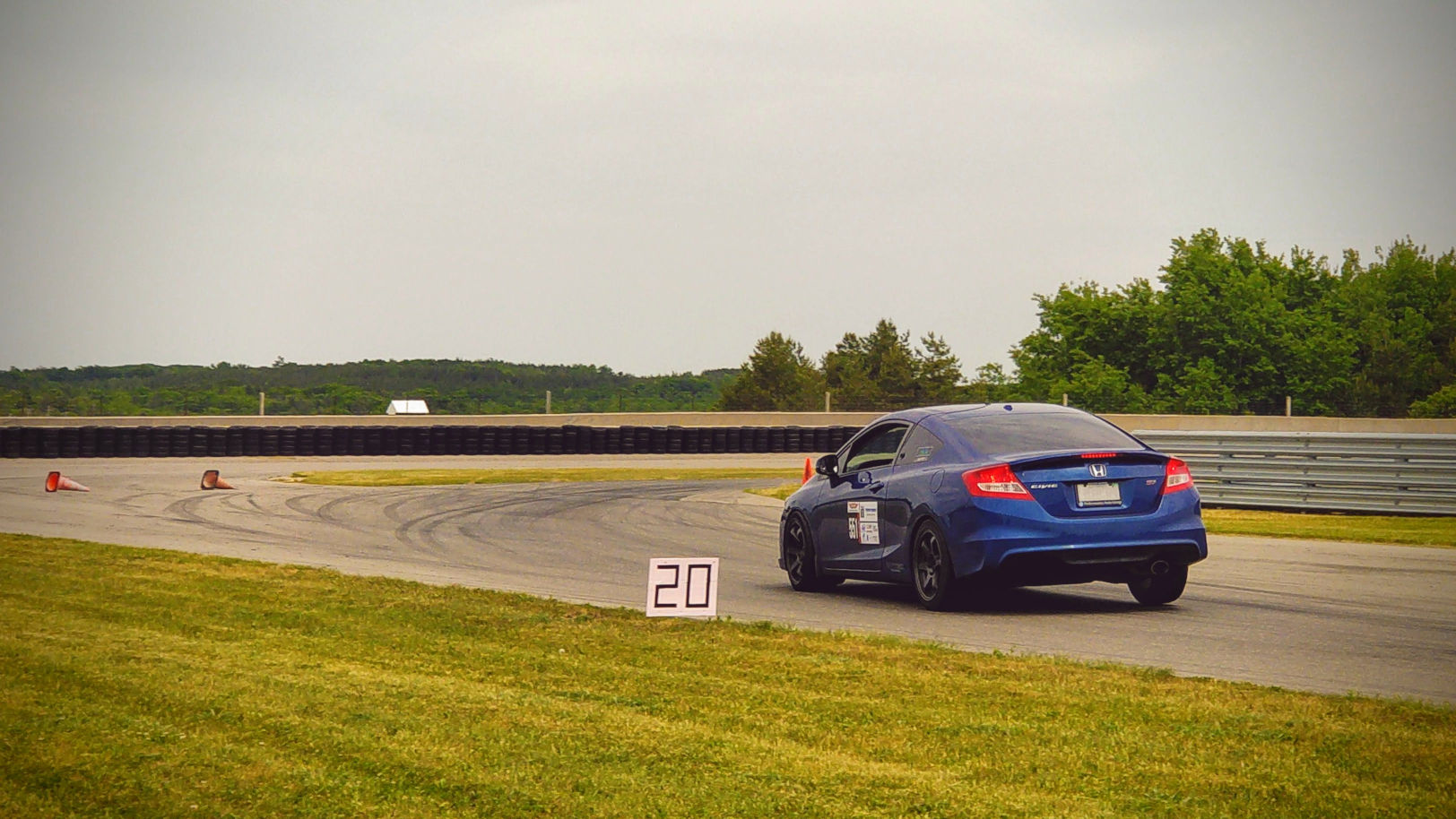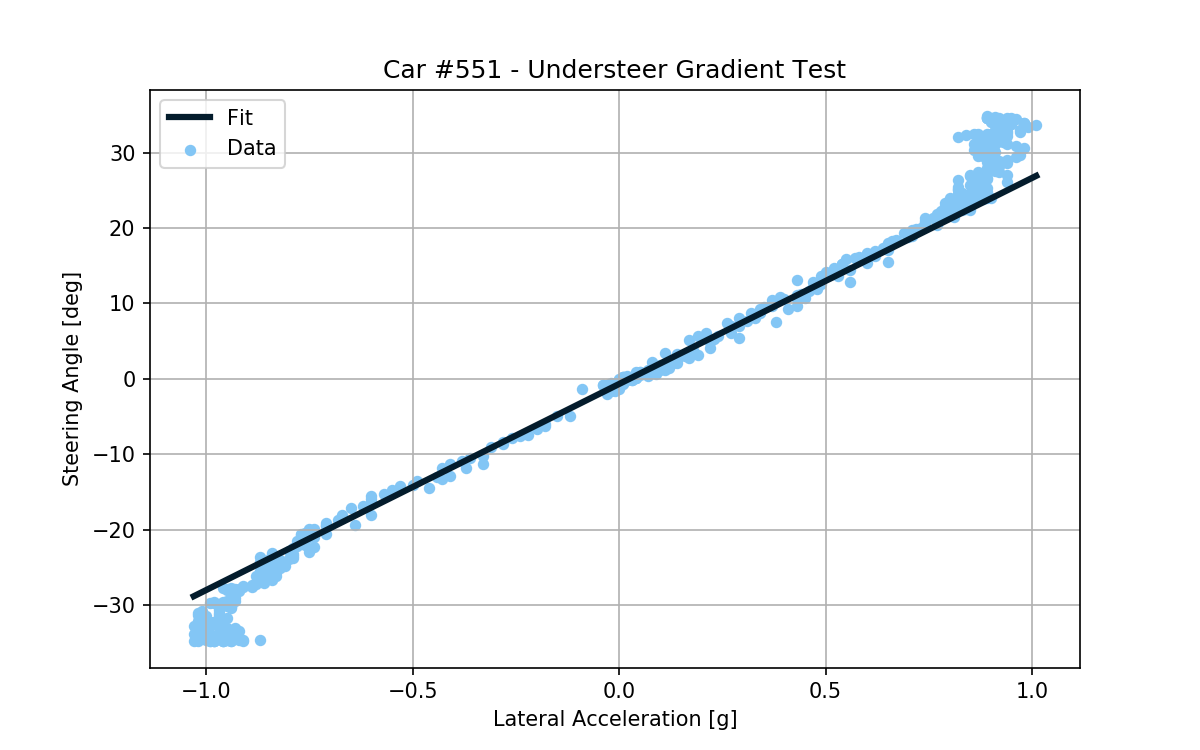OTA 2018 Debrief: Understeer Gradient Test
2019/08/22 update: this article is part of a series on on-centre vehicle handling using linear system analysis. For further reading, please feel free to check out my other posts:

Welcome to the Ontario Time Attack debrief files, a series of articles where we answer vehicle dynamics questions we always wanted to ask, but didn’t have the chance to tackle during the season. In this instalment, we perform an understeer gradient test to get an objective measure of vehicle handling.
Understeer, Defined
The tendency for a vehicle to require more (or less) steering input relative to the Ackermann steer angle is a measure of understeer. The gain due to lateral acceleration is the understeer gradient.
\[\delta = \frac{L}{R} + K a_y\]Where:
- \(\delta\) is the steering angle [rad]
- \(L\) is the wheelbase of the car [m]
- \(R\) is the radius of the turn [m]
- \(a_y\) is the lateral acceleration [m/s2]
- \(K\) is the understeer gradient [rad/m/s2]
Understeer can be measured by means of an understeer gradient test. For our purposes, we perform a constant speed test whereby the vehicle is kept at a constant forward speed and the steering slowly ramped to full lock.
The instantaneous path radius is calculated using circular motion. Differentiating the understeer equation and linearizing about zero lateral acceleration yields the on-centre understeer gradient.
\[K = \frac{d\delta}{da_y}\biggr\rvert_{a_y=0} - \frac{L}{V^2}\]Where:
- \(V\) is the forward speed of the vehicle [m/s]
We assume that the forward speed of the vehicle is constant. The understeer gradient can be computed if the lateral acceleration, forward speed and steering angle can be measured.
Experimental Setup

The target vehicle is a 2012 Honda Civic Si Coupe equipped with adjustable coilovers, staggered wheel sizing, bucket racing seat and roll bar. All data is collected with an Autosport Labs RaceCapture/Pro Mk2 data acquisition system. The data acquisition system is connected to the vehicle via the diagnostics port.
The constant speed understeer gradient test is performed on a flat testing area of a race track. This test is performed off the active track and in a designated testing area. Pedestrian and occupant safety is of utmost importance. Do not perform this test in an uncontrolled area.
A test speed of 30 km/h is chosen for safety purposes. This speed is relatively low compared to most on-track maneuvers; however, a low speed test reduces the likelihood of a loss-of-control. At no time did the vehicle operate outside the scope of driver control and at no time did the driver operate the vehicle in an unsafe manner.
The test is performed immediately after leaving the active track such that the tire temperatures and tire pressures are similar to those seen in racing conditions.
Analysis
We begin the vehicle analysis by declaring all known constants:
- \(L = 2.62\) [m]
- \(V = 30.0\) [km/h]
With the wheelbase and forward speed known, the Ackermann steer angle can be computed.
The next step is to identify the slope of the steering angle vs. lateral acceleration. The slope at zero lateral acceleration is approximated by performing a first-order polynomial fit about ±0.5 g.

The slope of the first-order polynomial fit yields the necessary value to evaluate the understeer gradient.
- \(\frac{d\delta}{da_y}\biggr\rvert_{a_y=0} = 27.7\) [deg/g]
Substituting these values into the understeer gradient equation yields the following:
\(K = 5.5\) [deg/g]
Summary
The purpose of performing the understeer gradient test is to obtain an objective measure of the vehicle’s handling characteristics. The understeer gradient test is easy to conduct, and with modern on-board diagnostics systems very little specialized instrumentation is required. While not a comprehensive measure of vehicle handling, it provides a data point for comparison.
A big thank you to OTA competitor Joseph Yang in the #551 2012 Honda Civic Si for performing the understeer gradient test and for providing the data used the analysis. This article would not be possible without the support of Joseph Yang and his sponsors.
References
- Milliken, William F., and Douglas L. Milliken. Race car vehicle dynamics. Vol. 400. Warrendale: Society of Automotive Engineers, 1995.
- Dixit, Neha R. Evaluation of Vehicle Understeer Gradient Definitions. Diss. The Ohio State University, 2009.